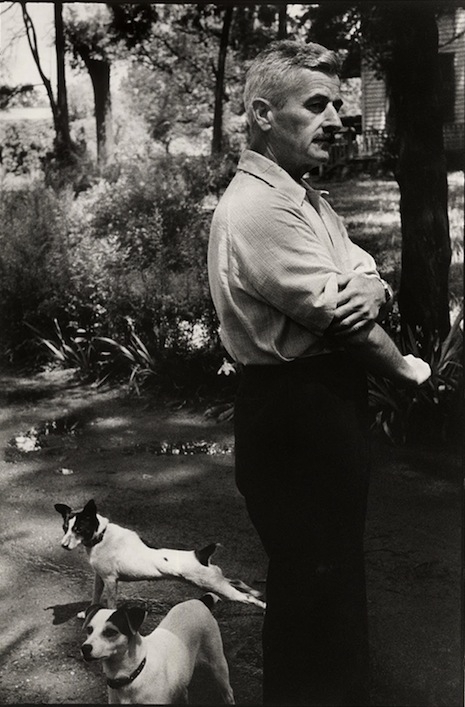
After William Faulkner won the Nobel Prize for Literature in 1949, there arose a consciousness that Americans might be interested to know more about him, so the Ford Foundation (apparently) put together a little movie about him. The result is one of the odder literary videos you are likely to find.
In effect, they made a docudrama of a day in the life of William Faulkner—starring William Faulkner as himself. The scenes are blocked, there are reverse angles and cuts, just as in an episode of, say, Leave It to Beaver. It’s incredibly stilted and stagey.
A narrator tendentiously explains some facts about Faulkner, emphasizing his ability to see into the hearts of many different kinds of people. There’s a passing effort at a framing device: a journalist friend of Faulkner’s, Phil “Moon” Mullen, visits Faulkner and tells him that someone—that is, Mullen—should write an article about him; Faulkner, after some unconvincing bluffing, agrees. Then (of course) we see a scene of Mullen at the typewriter writing the story.
The movie consists mostly of little vignettes in which Faulkner interacts with the local citizens of Oxford, Mississippi. To say that the dialogue is exposition-heavy is putting it mildly: “Moon asked me to write a piece for the paper about you. I told him about how our families have been friends for generations…. Then you wrote Sartoris, which we knew would sell and it didn’t sell. Then The Sound and the Fury, which was a fine book and didn’t sell….”
A little later he visits the local drugstore (which also sells books), and Faulkner converses with the proprietor as follows:
“By the way, whatever happened to all those books of mine you loaded yourself up with?”
“Oh I’m happy to tell you all of ‘em have been sold, Bill. I understand that they’re bringing premium prices now as collector’s items.”
“Funny how things turn out.”
And that’s the end of that scene.
The best thing about the movie is that you get to see some exteriors of 1950s Oxford as well as some interior shots of what I can only hope is Faulkner’s own house.
The whole thing is well shy of 20 minutes but has been broken up into 5 parts for no discernible reason.
We’ll start you off with the second part, which is a bit more engaging; the other four parts follow in order.
Via The Paris Review